THE LOST BOYS OF THE SUDAN
 Since 1983, the
Sudan People's Liberation Army (SPLA) and the Sudanese Government have
been at war in southern Sudan. The conflict has already claimed more than
500,000 lives and displaced huge numbers of people. Among these were at
least 20,000 children, mostly boys, between 7 and 17 years of age who were
separated from their families. These 'lost boys' of the Sudan trekked enormous
distances over a vast unforgiving wilderness, seeking refuge from the fighting.
Hungry, frightened and weakened by sleeplessness and disease, they crossed
from the Sudan into Ethiopia and back, with many dying along the way. The
survivors are now in camps in Kenya, the Sudan and Uganda. Since 1983, the
Sudan People's Liberation Army (SPLA) and the Sudanese Government have
been at war in southern Sudan. The conflict has already claimed more than
500,000 lives and displaced huge numbers of people. Among these were at
least 20,000 children, mostly boys, between 7 and 17 years of age who were
separated from their families. These 'lost boys' of the Sudan trekked enormous
distances over a vast unforgiving wilderness, seeking refuge from the fighting.
Hungry, frightened and weakened by sleeplessness and disease, they crossed
from the Sudan into Ethiopia and back, with many dying along the way. The
survivors are now in camps in Kenya, the Sudan and Uganda.
This extraordinary exodus has its origins in traditional forms of migration.
After being initiated into manhood, young adolescent boys in southern Sudan
have generally been quite mobile. Organized into small groups of their
peers, they would leave home for a period to look after cattle. Or they
might head for the towns or cities to go to school or to seek their fortune,
before eventually returning home. In addition, at times of stress families
all over Africa send their children elsewhere to find safety, food, work
and schooling.
But during the war this process has escalated dramatically. Fearing
they would be targeted as potential combatants, many boys left their villages
and headed for cities such as Juba and Khartoum. Here they hoped to find
work or schooling, though as these cities became saturated with migrants,
the boys often had to resort to begging or petty crime.
Others set out for refugee camps in Ethiopia. Some travelled with friends
or relatives, others slipped away on their own at night. Few had any idea
of what lay ahead of them. They believed the trek would last only a few
days and discovered that they faced a harrowing journey of 6 to 10 weeks.
Continually under threat, they would flee for their lives, losing their
way in the wilderness. Often they lost everything en route—blankets, sheets,
shoes, clothes and pots—to soldiers, swindlers or bandits. Many fell victim
to killer diseases. Others were so weakened by hunger and lack of sleep
that they could go no further and sat down by the roadside—prey for lions
and other animals.
The survivors who reached the camps in Ethiopia started to lead a relatively
peaceful life. But it was not to last. Following the change of government
in Ethiopia in May 1991 they had to flee again, back to camps in the Sudan.
This time the journey was during heavy rains, and many perished crossing
the swollen rivers or were hit by aerial bombardment. The luckier ones
made it to a camp where they received help from the International Committee
of the Red Cross.
This relative security was shattered again late in 1991 when fighting
erupted around them, and they and children from other camps were on the
move once more, eventually heading for Kenya.
Since 1992, UNICEF has managed to reunite nearly 1,200 boys with their
families. But approximately 17,000 remain in camps in the region. The harsh
memories remain as well. As 14-year-old Simon Majok puts it: "We were
suffering because of war. Some have been killed. Some have died because
of hunger and disease. We children of the Sudan, we were not lucky."
UNICEF
|